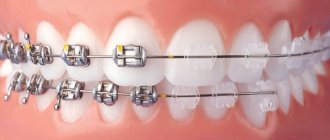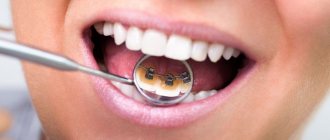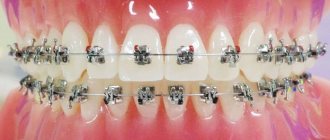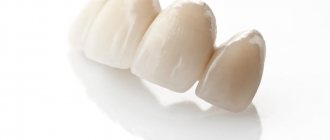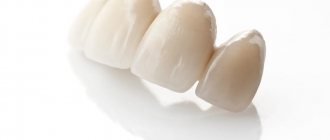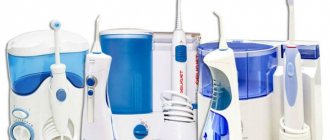Self-ligating braces are one of the modern types of dental correction. They have some advantages over traditional ligature ones. In some cases, self-ligating braces are used when complex pathology is detected, as the only method of treating the dentition without first removing the incisors.
Such systems are among the most common methods used in orthodontics. At the same time, self-ligating devices have a higher cost, in contrast to ligature (classical) types of braces.
The advantages of self-ligating braces according to reviews from orthodontists:
- Such systems adapt the teeth naturally, without damaging them with excessive pressure, that is, the dentition is corrected naturally.
- The system allows you to leave healthy teeth intact. The device adapts them and makes it possible to save them without prior surgical intervention.
- The use of such a device reduces the number of doctor visits by two to three times.
- They are quite convenient for patients.
Special elastic rubber rings are used as fastenings in classic braces. In newer models, the fastenings are replaced with metal micro-locks.
Types of ligature braces
Metal structures are classics, their effectiveness has been tested for decades. Of course, the appearance of these braces leaves much to be desired. However, due to its affordable price and high efficiency, this model still remains very popular. For those who are self-conscious about their smile, ceramic systems are offered. They are almost invisible, but their cost is much higher.
Ligature braces are superior to non-ligature braces in cost and practicality. However, in terms of convenience they are significantly inferior to other, more modern systems:
- In the first days after installation of such a device, the patient feels great discomfort in the jaw area. He has difficulty talking, eating and yawning.
- The elements of the device are massive. This makes daily cleaning difficult and worsens the appearance of the oral cavity.
- Due to the rapid wear of the ligatures, constant replacement is required, therefore, you have to frequently visit the dentist.
Sapphire and plastic braces - what to choose?
In addition to metal and ceramic, there are sapphire and plastic non-ligature braces.
The first ones are transparent, so they are barely noticeable on the teeth. This is one of the most aesthetic braces. But sapphire systems are not as durable as metal ones, so they are not used to correct complex malocclusions.
Plastic braces are the most budget-friendly braces, but in terms of strength and durability they are inferior to any other. They wear out quickly: they are washed off, stained by drinks or food. They are almost invisible on the teeth, which is a plus. But most patients prefer to install more reliable structures.
Non-ligature constructions
Just like ligature ones, they consist of an arc and fixing elements. The arc is fixed with metal micro-locks. The micro-lock cover is built into the bracket, so it is almost invisible. Systems are adjusted less frequently – approximately once every two to three months.
According to marketers, the treatment process is reduced by 20-30%. However, research has shown that this is just a marketing ploy. The duration of treatment does not depend on the type of braces.
Another myth is that self-ligating braces do not cause discomfort. This is explained by the fact that less pressure is exerted on the teeth compared to other types of systems. Elastic fastening ligaments do not allow high friction forces. As a result, the jaws do not suffer from excessive pressure. However, if the specialist is experienced and has installed the bracket system correctly, then even with a conventional device the patient will not feel any discomfort.
Duration of treatment with self-ligating braces
Self-ligating systems are more modern and comfortable designs for the patient and doctor. Thanks to soft forces and the involvement of the muscular system, teeth straightening occurs faster, more physiologically and is more easily detailed. On average, treatment time with such systems is 20% less than with ligature systems, that is, 1.5-2.5 years. At the same time, fewer visits to the orthodontist are required, since there are no ligatures that require regular replacement.
The Confidence Aesthetic Orthodontics Clinic works with Damon Q and Clear self-ligating braces. According to reviews from our patients, these are the most comfortable systems to care for and wear, with impressive results.
How do ligature-free braces work?
Crooked teeth can be treated with both ligature and non-ligature braces. In the first option, the doctor uses special rubber devices and a metal base to secure the teeth. This creates a reverse force from the jaw muscles, which allows the teeth to be aligned in the correct vertical position.
The difference between self-ligating braces and traditional braces is that they do not create additional pressure on the teeth, but simply fix the dentition. A straightening effect is created, as a result of which the teeth move much more easily.
Advantages of non-ligation braces:
- Aesthetic appearance. Fasteners that are located on the arc look more attractive in comparison with traditional metal fixtures.
- The curvature of the dentition is eliminated more easily due to the absence of friction.
- Getting used to the device in a short time.
- Teeth that interfere with correction are not removed, as was the case with ligature braces.
- Ligature-free braces do not cause mechanical damage to the mucous membrane and soft tissues of the oral cavity. The patient feels virtually no discomfort.
- There are no pain or complications with prolonged wearing.
- Can be removed and reinstalled in a short period of time.
- Patients who have been diagnosed with periodontitis should use only non-ligature braces when correcting their dentition.
- You can visit a personal specialist less often. To adjust the position of braces, it is enough to contact the orthodontist once every 60 days.
Contraindications to self-ligating braces
Absolute contraindications (under which treatment cannot be carried out):
- Diseases of the immune and endocrine systems, diabetes mellitus, oncology, mental disorders, blood diseases
- Pathologies of bone tissue. For teeth to move, bone tissue must be healthy and able to withstand the stress of orthodontic treatment.
- Most of the teeth are missing. In this case, the clinical situation is solved with the help of crowns, dentures and implants.
Relative contraindications (in which treatment can be carried out, but under the additional supervision of a specialist or after eliminating the problem):
- Periodontal diseases.
- Implants or crowns. Implants may prevent teeth from moving as planned and, in this case, treatment will be a compromise. It is possible to put braces on crowns, but there is a risk that after moving the teeth they will lose their original appearance.
- Caries or inflammatory processes in the oral cavity.
- Pregnancy and breastfeeding.
Non-ligature systems made of metal
Non-ligature metal braces are one of the most common types of devices in domestic dentistry. The only drawback of the system is the aesthetics of the design. But due to their high efficiency and increased durability, many patients do not attach much importance to their appearance.
- Model Damon 3MX. For many years it was considered one of the most advanced models of braces systems. The design does not have sharp protrusions, which ensures quick adaptation and no discomfort during the treatment process.
- Damon Q is another braces model from the same manufacturer. The system is customized to suit the jaw characteristics of each patient. An experienced doctor will be able to correctly predict treatment, and using this model, a positive result will be achieved in a short period.
- Smart Clip. Officially patented non-ligature system. Thanks to the design feature, it is possible to adjust the arc strength and, if necessary, change it in the desired direction to achieve maximum therapeutic results.
- Inovation K is a small bracket system that allows you to install an individual arch into the structure to suit the dimensions of the oral cavity of a particular patient. The developers used latches as fasteners, which additionally influence the arc and shorten the treatment period.
Operating principle of self-ligating systems
Scientists are constantly looking for innovative solutions that will straighten teeth with maximum comfort and in a short time. A breakthrough in this area was the invention of self-ligation technology. This principle implies that the arc is held in the groove without the help of wire or elastic ligatures. It is fixed in place using a special smooth cover. This cover is an integral part of the design of the bracket itself. It covers the arc and prevents it from slipping out of the groove. There are two types of self-ligating systems:
- Active self-ligation - the cover presses on the arc, pressing it tightly to the bottom of the groove.
- Passive self-ligation - the cover does not put pressure on the arc, it can slide freely in the groove.
Passive self-ligation is considered preferable. It avoids friction and excessive impact on the periodontium and bone tissue. In such a system, tooth movement is carried out by weak, physiological forces. The gentle effect on the dental system contributes to patient comfort. at the same time, the system is characterized by very high efficiency.
Non-ligature ceramic systems
Such systems are developed on a ceramic basis: small crystals or granules. The size of the crystals directly affects the strength of the system - the smaller they are, the stronger. However, there is a minor drawback: small granules have lower transparency. Despite the fact that these braces are slightly stronger than metal ones, they look much more aesthetically pleasing. To increase strength, metal components are added to the material for making ceramic models.
Several famous ceramic models:
- Clarity SL. Such models use materials using aluminum oxide. This is the only model whose design uses a minimum amount of metal elements.
- Inovation C. A model that was designed relatively recently. It combines the advantages of a metal analogue of the same name and a wonderful aesthetic appearance. The design consists of a transparent ceramic material with a top layer of silicon oxide. Thanks to this composition, braces look attractive and do an excellent job of their main task - correcting the bite.
- Damon Clear. Braces that are practically invisible on the surface of the teeth. They are made from a special material – sapphire. Another significant advantage is that they do not change color under the influence of dyes.
PATIENTS' REVIEWS ABOUT SELF-LIGING BRACKETS ACCORDING TO VIP PROTOCOL.
Look at the review of our patient, actress and TV presenter Yana Troyanova, about teeth straightening in our clinic using the VIP protocol.
Teeth straightening and bite correction with self-ligating braces from one of the best orthodontists in Moscow.
Orthodontic treatment at the Bionic Dentis clinic is carried out by Dr. Ovsyanik Alexander Vadimovich, an orthodontist with 11 years of experience.
According to an independent study, Alexander Vadimovich Ovsyanik ranks third in the ranking of orthodontists in Moscow.
Which are better, ligature or non-ligature braces?
Some dentists believe that ligature-free braces are much better, since the design was created using technology that appeared not so long ago. The attachment of braces has really changed. It is now much easier for specialists to work with such models. But, from the point of view of biomechanics, arches in two designs from different generations work absolutely the same. It is difficult to assess the separation effectiveness of one bracket system from another. It all depends on the pathology that the patient suffers from. Based on this, the choice is made.
A specialist should choose a model of braces. He will recommend a suitable device depending on the individual characteristics of the client. To do this, the specialist studies the clinical picture of the patient’s dentition. Based on the results and analyses, the orthodontist offers several options for devices to choose from. Now the client chooses from the available assortment, justifying his choice with financial capabilities and personal wishes.
Procedure for installing braces
The installation of self-ligating braces does not differ from the fixation of traditional systems and is carried out in several successive stages:
- Comprehensive diagnostics, assessment of the condition of the oral cavity, sanitation, and, if necessary, surgical interventions, for example, removal of figure eights before installing braces. Professional teeth cleaning – removal of plaque and tartar. The smooth surface of the teeth allows for better fixation of braces, so cleaning is a mandatory first step of installation;
- Fixing braces on the surface of the teeth using special dental glue;
- Connecting locks using an arc fixed in the grooves.
Usually, preparation does not take much time; depending on the condition of the dental system, it can take up to 1-2 weeks. And installing braces usually lasts no more than an hour. It is important to note that in most cases, installation is first carried out on one jaw, and only after a few weeks - on the second. This is necessary in order to reduce discomfort in the first days of wearing the system. However, in rare cases, you can get by with installing braces on only one jaw, while in others they are installed on both the upper and lower teeth at once - usually with slight crowding or slight curvature of the teeth.
How to care for braces?
Regardless of the type of braces used, ligature or non-ligature, they require careful care. It should be noted that you cannot limit yourself to brushing your teeth in the morning and evening. Due to the fact that braces have protrusions and different methods of fastening, cleaning out food debris becomes problematic.
According to the doctor's recommendations, you will need to purchase a special dental solution, a large brush, a small brush and dental floss from the pharmacy. Oral hygiene will have to be done after every meal. First of all, you need to use a large brush that will remove large food debris from the tooth surface. Then you can move on to a fine brush. Using such a hygienic tool, you can remove germs in hard-to-reach places. The final stage is using dental floss. Only after such manipulations can oral hygiene be completed. One procedure takes on average 10-15 minutes after each meal. On average, it will take 30-40 minutes a day to clean your braces and mouth from bacteria.
Please note: braces can only be installed on completely healthy teeth. If treatment is required for periodontitis or other diseases of the teeth and gums, these problems are first eliminated, and only then the system is installed.
Sincerely, Levin D.V., chief physician
Main advantages of orthodontic plates
Plates for teeth straightening have the following advantages:
- comfortable wearing;
- fast production;
- low cost.
Both children and adults get used to the plates for teeth correction without any problems. The device is easy to remove, so eating, brushing your teeth and performing responsibly in public will not cause the slightest difficulty.
The advisability of installing a plate is determined by the attending physician or during a consultation, which can be obtained at the DentBerg clinic absolutely free of charge.
Our clinic in Moscow provides a full range of orthodontic services using effective techniques and high-quality materials. We guarantee excellent results.
